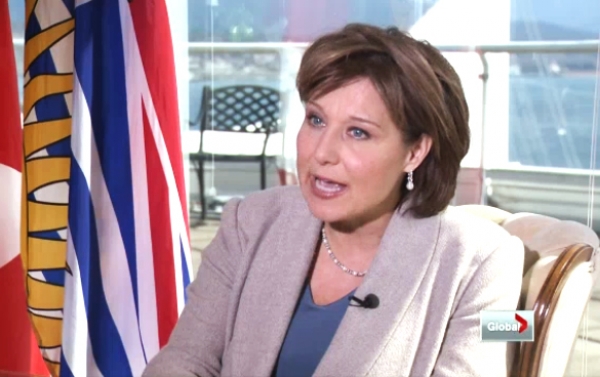
Premier Christy Clark wants BC citizens to subsidize the oil and gas industry with a $10 Billion taxpayer-funded dam. Though she won’t put it quite like that, that’s precisely the implication of the policies she’s promoting in the run-up to May’s provincial election.
Clark confirmed her vision for powering a new, much-ballyhooed Liquified Natural Gas (LNG) Industry to Global TV last week (a must-watch). The premier has promised in recent months a $100 Billion windfall of provincial revenues from the yet-to-be-developed LNG industry, a boast which has drawn justified ridicule from pundits.
LNG requires enormous amounts of energy to super-cool gas in order to liquefy it and load it onto tankers. Numerous global energy companies – including Shell, Chevron, and a number of big Asian players – have lined up over the past year to build LNG plants in Kitimat and Prince Rupert, in order to access Asian markets which are currently paying significantly more for gas than the North American market.
Clark acknowledges the province doesn’t have enough electricity to supply the demands of multiple proposed LNG facilities. Her solution? Flood an 80 km stretch of the fertile Peace Valley in northeast BC to build a new dam. Dubbed Site “C” because it would be the third dam on the Peace River, the project would flood some 20,000 acres of high quality agricultural land and wildlife habitat.
Clark was blunt with Global TV reporter Jas Johal:
[quote]You can’t power up these huge [LNG] facilities without more power, so BC Hydro’s going to have to build Site C – we’re in favour of making that happen.[/quote]
The statement came as the window for public comments to the environmental assessment process for Site C winds down, drawing to a close Thursday, April 4.
Last year, at a press conference in Fort St. John, near the location of the proposed dam, Premier Clark spoke to the need for Site C to power LNG. She acknowledged that just one of the 5 or 6 planned LNG terminals on BC’s coast – a proposal by Shell and its Chinese, Korean and Japanese partners – would eat up the entire 1,100 megawatt output of Site C.
So even with this new dam – which won’t be up and running until 2020 at the earliest – BC has nowhere near the energy required to power the energy-hungry LNG industry. To that end, Premier Clark created a loophole in the Clean Energy Act to allow gas companies to generate power for their plants by burning their own natural gas. Which begs the question: why the continued need for Site C?
Perhaps it’s because the power from Site C would be offered to gas producers at a steep discount, which is the standard for large industrial users, who typically pay less than half what residential and small business customers pay for hydroelectricity in BC.
When pressed by Johal on the taxpayer subsidy issue, Clark brushed it off – “That’s not part of what we’re negotiating…We aren’t going to ask residential taxpayers to subsidize this.”
And yet, the dam itself, pegged at $8 Billion but sure to balloon beyond that (a study of 70 large dam projects funded by the World Bank found that the average overrun was a whopping 27%), will be on the shoulders of taxpayers and crown corporation BC Hydro – already drowing in massive debt. And unless the plan is to make the LNG industry pay top dollar for this new power (which defeats the purpose entirely), then residential hydro customers will bear the full burden through much steeper power bills.
While Site C is a looming taxpayer boondoggle, it will also destroy precious farmland at a time when we produce just 40% of our own food in BC. And as this recent report from the David Suzuki Foundation shows, it will compound the enormous industrial footprint that has marred over 65% of the Peace Valley over the past half century – making it easily one of the world’s most heavily impacted regions already.
A major source of those impacts is the natural gas industry, which relies more and more on environmentally risky “fracking” to extract the gas that would flow to these LNG plants through multiple new pipelines.
So Site C and LNG mean a major ramping up of increasingly controversial fracking.
Clark’s opposition in the upcoming provincial election on May 14, the BC NDP, are showing signs of backing away from Site C. The party’s Energy Critic John Horgan told the Vancouver Sun in February, “I’m confident that in the first two years of an NDP government we won’t be building Site C.”
For more information on Site C and tools to help you submit your comments to the environmental assessment process by the April 4 deadline, click here.

